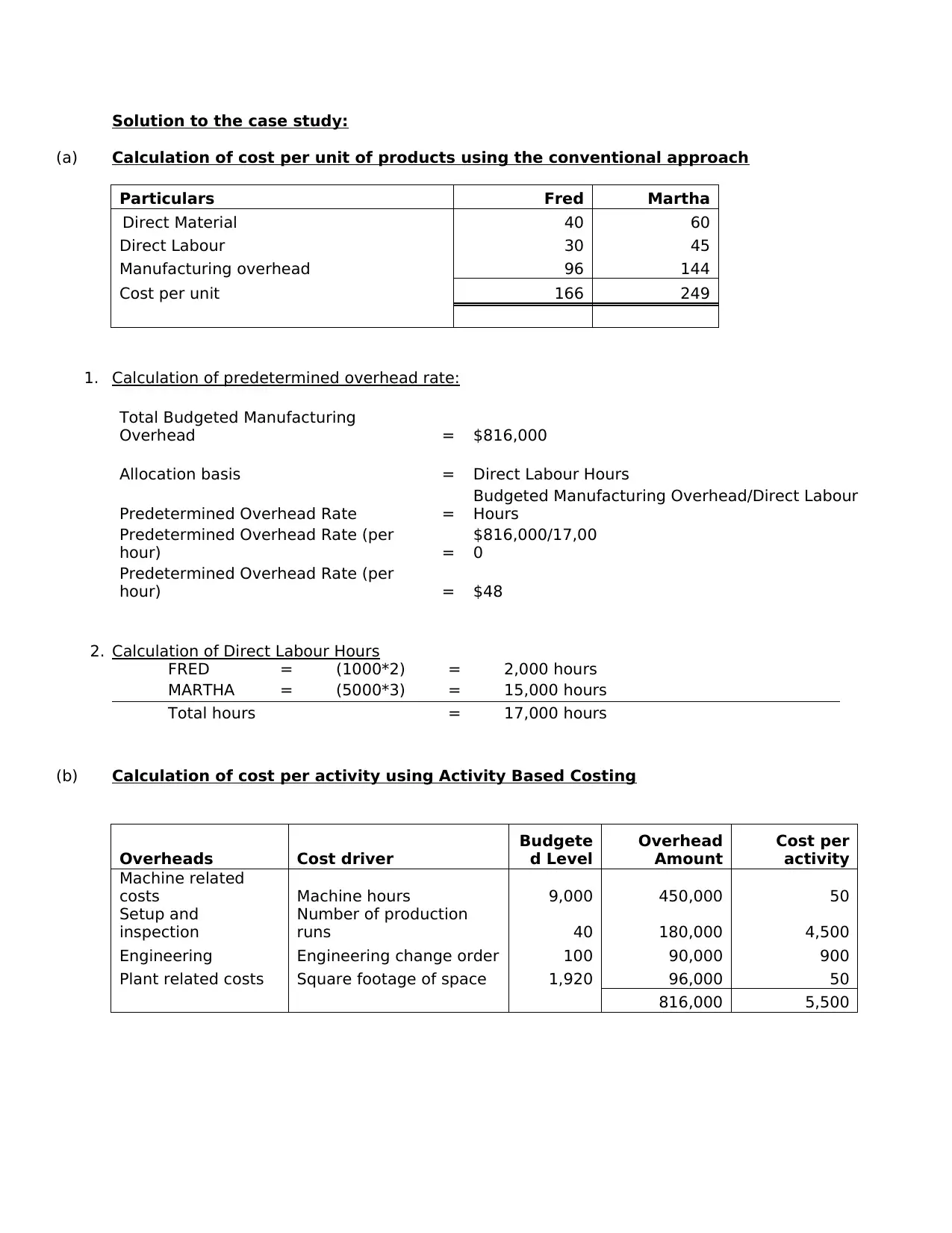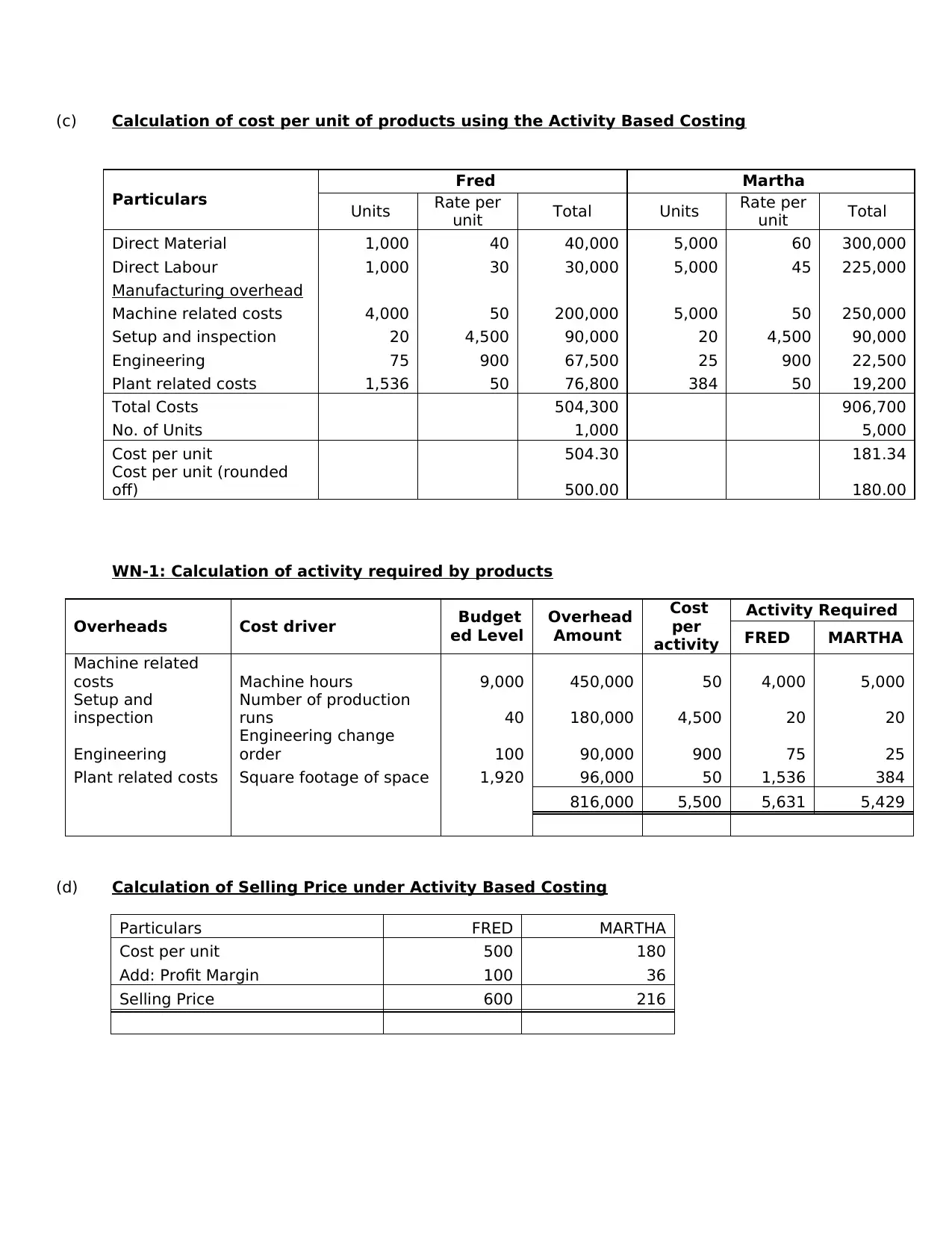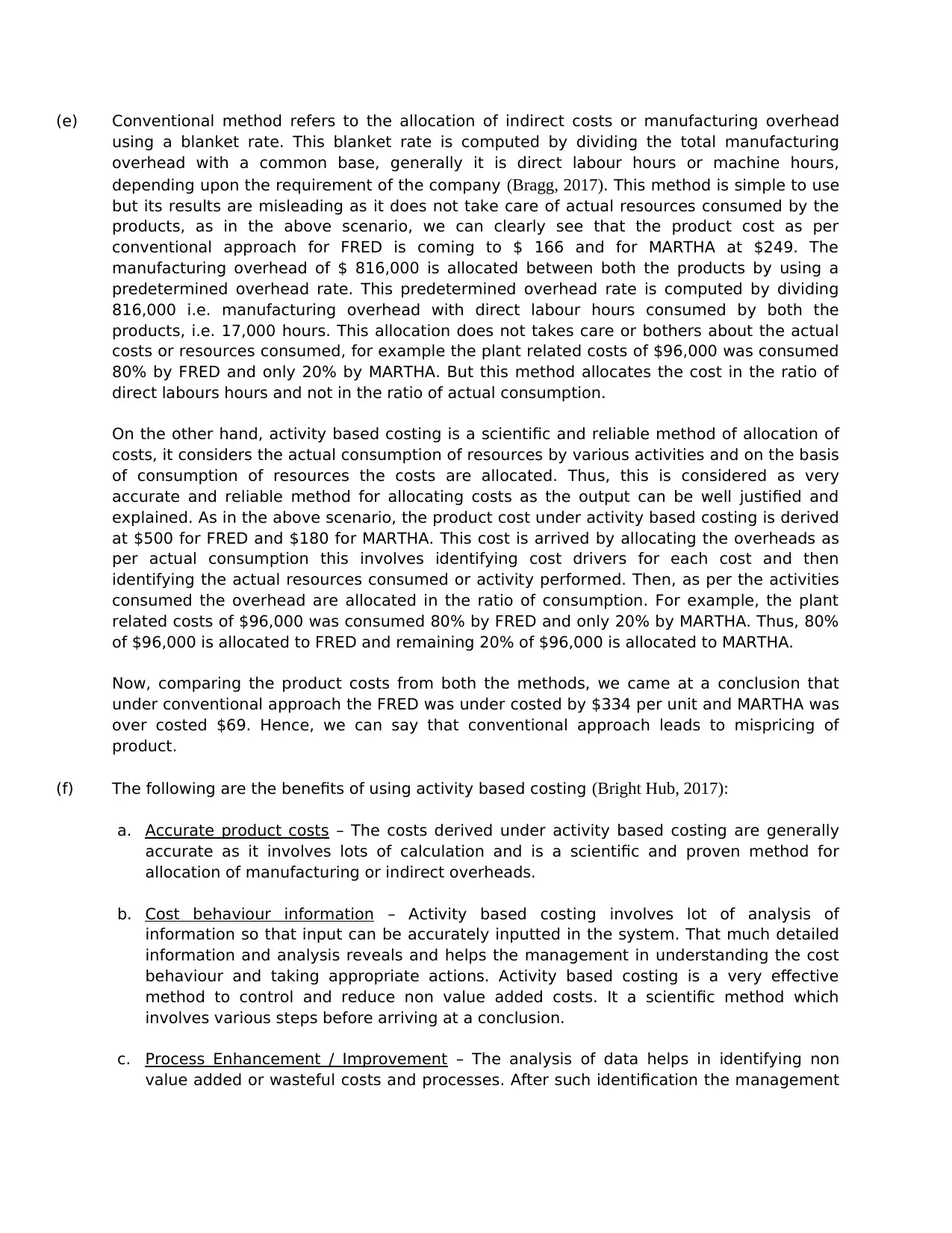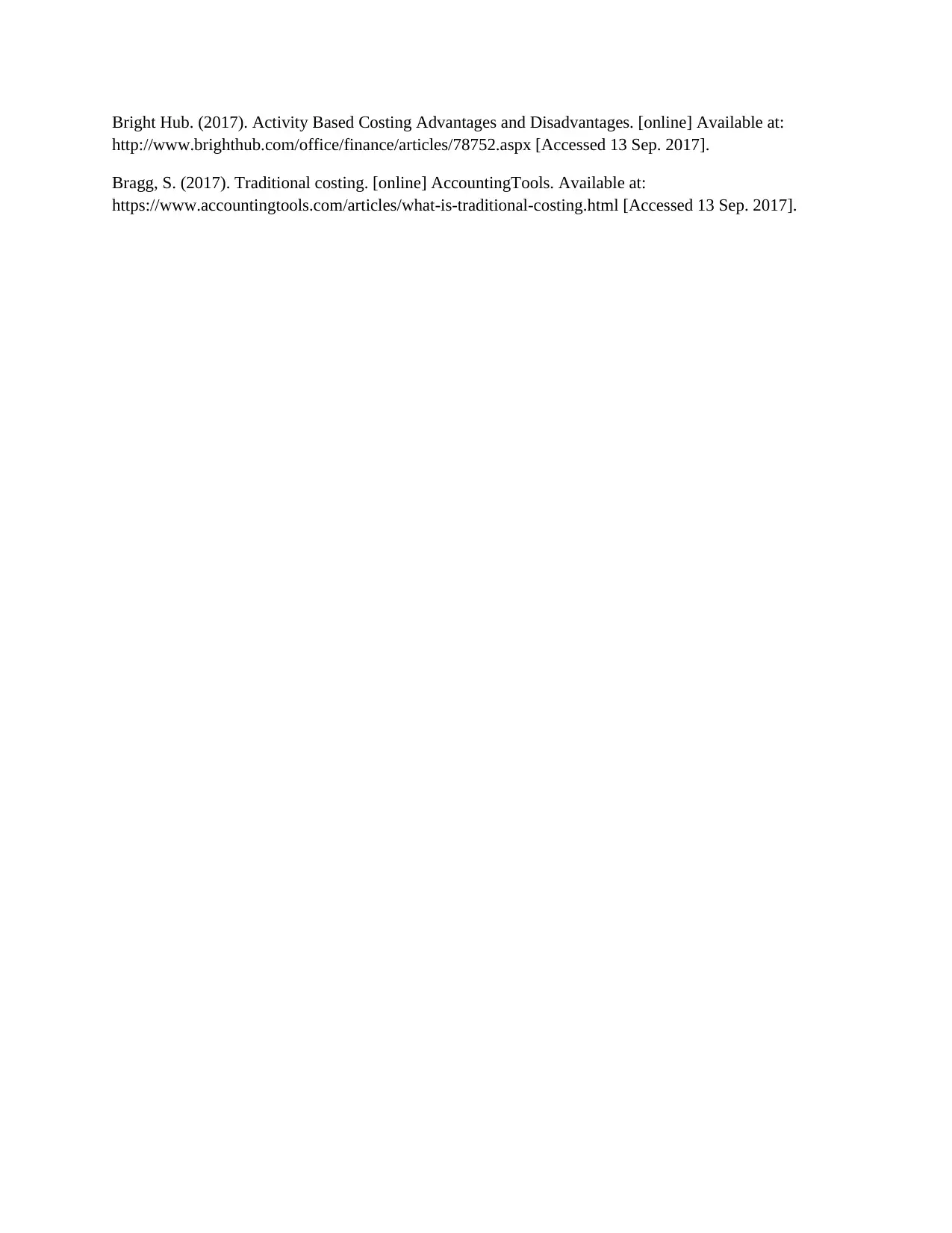University Finance Case Study: Costing Methods Comparison and Analysis
VerifiedAdded on 2019/10/30
|5
|1479
|439
Case Study
AI Summary
This case study analyzes and compares two primary costing methods: conventional costing and activity-based costing (ABC). The assignment begins with a detailed calculation of cost per unit using the conventional approach, including direct materials, direct labor, and manufacturing overhead. It then calculates the predetermined overhead rate. Subsequently, the case study transitions to ABC, outlining the allocation of overhead costs based on various cost drivers like machine hours and engineering change orders. The analysis provides a comprehensive comparison of the cost per unit for two products (Fred and Martha) under both methods. The study highlights the advantages of ABC, such as accurate product costing and better cost behavior information, while also acknowledging its disadvantages, including higher implementation costs and data accuracy concerns. The document concludes by emphasizing how ABC can lead to improved pricing strategies and better decision-making within a business context. The case study includes calculations, and references supporting the analysis.

Solution to the case study:
(a) Calculation of cost per unit of products using the conventional approach
Particulars Fred Martha
Direct Material 40 60
Direct Labour 30 45
Manufacturing overhead 96 144
Cost per unit 166 249
1. Calculation of predetermined overhead rate:
Total Budgeted Manufacturing
Overhead = $816,000
Allocation basis = Direct Labour Hours
Predetermined Overhead Rate =
Budgeted Manufacturing Overhead/Direct Labour
Hours
Predetermined Overhead Rate (per
hour) =
$816,000/17,00
0
Predetermined Overhead Rate (per
hour) = $48
2. Calculation of Direct Labour Hours
FRED = (1000*2) = 2,000 hours
MARTHA = (5000*3) = 15,000 hours
Total hours = 17,000 hours
(b) Calculation of cost per activity using Activity Based Costing
Overheads Cost driver
Budgete
d Level
Overhead
Amount
Cost per
activity
Machine related
costs Machine hours 9,000 450,000 50
Setup and
inspection
Number of production
runs 40 180,000 4,500
Engineering Engineering change order 100 90,000 900
Plant related costs Square footage of space 1,920 96,000 50
816,000 5,500
(a) Calculation of cost per unit of products using the conventional approach
Particulars Fred Martha
Direct Material 40 60
Direct Labour 30 45
Manufacturing overhead 96 144
Cost per unit 166 249
1. Calculation of predetermined overhead rate:
Total Budgeted Manufacturing
Overhead = $816,000
Allocation basis = Direct Labour Hours
Predetermined Overhead Rate =
Budgeted Manufacturing Overhead/Direct Labour
Hours
Predetermined Overhead Rate (per
hour) =
$816,000/17,00
0
Predetermined Overhead Rate (per
hour) = $48
2. Calculation of Direct Labour Hours
FRED = (1000*2) = 2,000 hours
MARTHA = (5000*3) = 15,000 hours
Total hours = 17,000 hours
(b) Calculation of cost per activity using Activity Based Costing
Overheads Cost driver
Budgete
d Level
Overhead
Amount
Cost per
activity
Machine related
costs Machine hours 9,000 450,000 50
Setup and
inspection
Number of production
runs 40 180,000 4,500
Engineering Engineering change order 100 90,000 900
Plant related costs Square footage of space 1,920 96,000 50
816,000 5,500
Paraphrase This Document
Need a fresh take? Get an instant paraphrase of this document with our AI Paraphraser

(c) Calculation of cost per unit of products using the Activity Based Costing
Particulars
Fred Martha
Units Rate per
unit Total Units Rate per
unit Total
Direct Material 1,000 40 40,000 5,000 60 300,000
Direct Labour 1,000 30 30,000 5,000 45 225,000
Manufacturing overhead
Machine related costs 4,000 50 200,000 5,000 50 250,000
Setup and inspection 20 4,500 90,000 20 4,500 90,000
Engineering 75 900 67,500 25 900 22,500
Plant related costs 1,536 50 76,800 384 50 19,200
Total Costs 504,300 906,700
No. of Units 1,000 5,000
Cost per unit 504.30 181.34
Cost per unit (rounded
off) 500.00 180.00
WN-1: Calculation of activity required by products
Overheads Cost driver Budget
ed Level
Overhead
Amount
Cost
per
activity
Activity Required
FRED MARTHA
Machine related
costs Machine hours 9,000 450,000 50 4,000 5,000
Setup and
inspection
Number of production
runs 40 180,000 4,500 20 20
Engineering
Engineering change
order 100 90,000 900 75 25
Plant related costs Square footage of space 1,920 96,000 50 1,536 384
816,000 5,500 5,631 5,429
(d) Calculation of Selling Price under Activity Based Costing
Particulars FRED MARTHA
Cost per unit 500 180
Add: Profit Margin 100 36
Selling Price 600 216
Particulars
Fred Martha
Units Rate per
unit Total Units Rate per
unit Total
Direct Material 1,000 40 40,000 5,000 60 300,000
Direct Labour 1,000 30 30,000 5,000 45 225,000
Manufacturing overhead
Machine related costs 4,000 50 200,000 5,000 50 250,000
Setup and inspection 20 4,500 90,000 20 4,500 90,000
Engineering 75 900 67,500 25 900 22,500
Plant related costs 1,536 50 76,800 384 50 19,200
Total Costs 504,300 906,700
No. of Units 1,000 5,000
Cost per unit 504.30 181.34
Cost per unit (rounded
off) 500.00 180.00
WN-1: Calculation of activity required by products
Overheads Cost driver Budget
ed Level
Overhead
Amount
Cost
per
activity
Activity Required
FRED MARTHA
Machine related
costs Machine hours 9,000 450,000 50 4,000 5,000
Setup and
inspection
Number of production
runs 40 180,000 4,500 20 20
Engineering
Engineering change
order 100 90,000 900 75 25
Plant related costs Square footage of space 1,920 96,000 50 1,536 384
816,000 5,500 5,631 5,429
(d) Calculation of Selling Price under Activity Based Costing
Particulars FRED MARTHA
Cost per unit 500 180
Add: Profit Margin 100 36
Selling Price 600 216

(e) Conventional method refers to the allocation of indirect costs or manufacturing overhead
using a blanket rate. This blanket rate is computed by dividing the total manufacturing
overhead with a common base, generally it is direct labour hours or machine hours,
depending upon the requirement of the company (Bragg, 2017). This method is simple to use
but its results are misleading as it does not take care of actual resources consumed by the
products, as in the above scenario, we can clearly see that the product cost as per
conventional approach for FRED is coming to $ 166 and for MARTHA at $249. The
manufacturing overhead of $ 816,000 is allocated between both the products by using a
predetermined overhead rate. This predetermined overhead rate is computed by dividing
816,000 i.e. manufacturing overhead with direct labour hours consumed by both the
products, i.e. 17,000 hours. This allocation does not takes care or bothers about the actual
costs or resources consumed, for example the plant related costs of $96,000 was consumed
80% by FRED and only 20% by MARTHA. But this method allocates the cost in the ratio of
direct labours hours and not in the ratio of actual consumption.
On the other hand, activity based costing is a scientific and reliable method of allocation of
costs, it considers the actual consumption of resources by various activities and on the basis
of consumption of resources the costs are allocated. Thus, this is considered as very
accurate and reliable method for allocating costs as the output can be well justified and
explained. As in the above scenario, the product cost under activity based costing is derived
at $500 for FRED and $180 for MARTHA. This cost is arrived by allocating the overheads as
per actual consumption this involves identifying cost drivers for each cost and then
identifying the actual resources consumed or activity performed. Then, as per the activities
consumed the overhead are allocated in the ratio of consumption. For example, the plant
related costs of $96,000 was consumed 80% by FRED and only 20% by MARTHA. Thus, 80%
of $96,000 is allocated to FRED and remaining 20% of $96,000 is allocated to MARTHA.
Now, comparing the product costs from both the methods, we came at a conclusion that
under conventional approach the FRED was under costed by $334 per unit and MARTHA was
over costed $69. Hence, we can say that conventional approach leads to mispricing of
product.
(f) The following are the benefits of using activity based costing (Bright Hub, 2017):
a. Accurate product costs – The costs derived under activity based costing are generally
accurate as it involves lots of calculation and is a scientific and proven method for
allocation of manufacturing or indirect overheads.
b. Cost behaviour information – Activity based costing involves lot of analysis of
information so that input can be accurately inputted in the system. That much detailed
information and analysis reveals and helps the management in understanding the cost
behaviour and taking appropriate actions. Activity based costing is a very effective
method to control and reduce non value added costs. It a scientific method which
involves various steps before arriving at a conclusion.
c. Process Enhancement / Improvement – The analysis of data helps in identifying non
value added or wasteful costs and processes. After such identification the management
using a blanket rate. This blanket rate is computed by dividing the total manufacturing
overhead with a common base, generally it is direct labour hours or machine hours,
depending upon the requirement of the company (Bragg, 2017). This method is simple to use
but its results are misleading as it does not take care of actual resources consumed by the
products, as in the above scenario, we can clearly see that the product cost as per
conventional approach for FRED is coming to $ 166 and for MARTHA at $249. The
manufacturing overhead of $ 816,000 is allocated between both the products by using a
predetermined overhead rate. This predetermined overhead rate is computed by dividing
816,000 i.e. manufacturing overhead with direct labour hours consumed by both the
products, i.e. 17,000 hours. This allocation does not takes care or bothers about the actual
costs or resources consumed, for example the plant related costs of $96,000 was consumed
80% by FRED and only 20% by MARTHA. But this method allocates the cost in the ratio of
direct labours hours and not in the ratio of actual consumption.
On the other hand, activity based costing is a scientific and reliable method of allocation of
costs, it considers the actual consumption of resources by various activities and on the basis
of consumption of resources the costs are allocated. Thus, this is considered as very
accurate and reliable method for allocating costs as the output can be well justified and
explained. As in the above scenario, the product cost under activity based costing is derived
at $500 for FRED and $180 for MARTHA. This cost is arrived by allocating the overheads as
per actual consumption this involves identifying cost drivers for each cost and then
identifying the actual resources consumed or activity performed. Then, as per the activities
consumed the overhead are allocated in the ratio of consumption. For example, the plant
related costs of $96,000 was consumed 80% by FRED and only 20% by MARTHA. Thus, 80%
of $96,000 is allocated to FRED and remaining 20% of $96,000 is allocated to MARTHA.
Now, comparing the product costs from both the methods, we came at a conclusion that
under conventional approach the FRED was under costed by $334 per unit and MARTHA was
over costed $69. Hence, we can say that conventional approach leads to mispricing of
product.
(f) The following are the benefits of using activity based costing (Bright Hub, 2017):
a. Accurate product costs – The costs derived under activity based costing are generally
accurate as it involves lots of calculation and is a scientific and proven method for
allocation of manufacturing or indirect overheads.
b. Cost behaviour information – Activity based costing involves lot of analysis of
information so that input can be accurately inputted in the system. That much detailed
information and analysis reveals and helps the management in understanding the cost
behaviour and taking appropriate actions. Activity based costing is a very effective
method to control and reduce non value added costs. It a scientific method which
involves various steps before arriving at a conclusion.
c. Process Enhancement / Improvement – The analysis of data helps in identifying non
value added or wasteful costs and processes. After such identification the management
⊘ This is a preview!⊘
Do you want full access?
Subscribe today to unlock all pages.

Trusted by 1+ million students worldwide

can take relevant actions for eliminating such processes or costs and thus it helps in
improving the processes.
d. Proper utilization of capacity - Activity based costing helps in identifying the wasteful
activities by pooing the various costs with their cost drivers and then allocating the
costs according to their consumption by various products and thus after knowing these
activities management can plan their utilization in a more meaningful way and can use
its resources optimally.
e. Improvement in Pricing Strategies – Reduction in costs make the prices competitive and
the management can make appropriate pricing strategies. In many cases, using activity
based costing reduces the cost of the product and make the product cheaper in the
market which helps in companies in capturing more market share.
f. Better Decision Making - Activity based costing also helps in taking better decision by
providing correct information to the management. Activity based costing is more helpful
with industries having voluminous data including customers, products, sales, purchase,
etc. as it makes the costing systematic.
(g) Yes, there are many disadvantages of this method as well. The following are the
disadvantages of using activity based costing (Bright Hub, 2017):
a. Expensive and Higher Implementation costs - High cost of implementation is involved in
activity based costing. As experts are required to collection of data and feeding that
information in the system for proper and successful implementation. Further, the
collection of data and sorting it according it activity based costing also involves lot of
efforts and energy of the business staff which can prove to be useless if the savings in
cost is not much to cover the implementation costs of activity based costing.
b. Accuracy of Data – This method requires input data to be managed and collected from
various departments or sources. As the complete implementations or system depend
upon these input data. If the data inputted contains any flaw, then the results or output
generated from Activity Based Costing will not show the correct results. So, the
accuracy of data is of greater priority and importance.
c. Lengthy process – It is a time consuming and a lengthy process as it involves collecting,
verifying and examining the input data.
d. Not useful for smaller companies – Due to higher implementation and data collection
costs, this method does not prove useful for smaller companies as they cannot afford
such a high level of costs. Further, if the amount of overhead is small then also this
method is of no use.
References:
improving the processes.
d. Proper utilization of capacity - Activity based costing helps in identifying the wasteful
activities by pooing the various costs with their cost drivers and then allocating the
costs according to their consumption by various products and thus after knowing these
activities management can plan their utilization in a more meaningful way and can use
its resources optimally.
e. Improvement in Pricing Strategies – Reduction in costs make the prices competitive and
the management can make appropriate pricing strategies. In many cases, using activity
based costing reduces the cost of the product and make the product cheaper in the
market which helps in companies in capturing more market share.
f. Better Decision Making - Activity based costing also helps in taking better decision by
providing correct information to the management. Activity based costing is more helpful
with industries having voluminous data including customers, products, sales, purchase,
etc. as it makes the costing systematic.
(g) Yes, there are many disadvantages of this method as well. The following are the
disadvantages of using activity based costing (Bright Hub, 2017):
a. Expensive and Higher Implementation costs - High cost of implementation is involved in
activity based costing. As experts are required to collection of data and feeding that
information in the system for proper and successful implementation. Further, the
collection of data and sorting it according it activity based costing also involves lot of
efforts and energy of the business staff which can prove to be useless if the savings in
cost is not much to cover the implementation costs of activity based costing.
b. Accuracy of Data – This method requires input data to be managed and collected from
various departments or sources. As the complete implementations or system depend
upon these input data. If the data inputted contains any flaw, then the results or output
generated from Activity Based Costing will not show the correct results. So, the
accuracy of data is of greater priority and importance.
c. Lengthy process – It is a time consuming and a lengthy process as it involves collecting,
verifying and examining the input data.
d. Not useful for smaller companies – Due to higher implementation and data collection
costs, this method does not prove useful for smaller companies as they cannot afford
such a high level of costs. Further, if the amount of overhead is small then also this
method is of no use.
References:
Paraphrase This Document
Need a fresh take? Get an instant paraphrase of this document with our AI Paraphraser

Bright Hub. (2017). Activity Based Costing Advantages and Disadvantages. [online] Available at:
http://www.brighthub.com/office/finance/articles/78752.aspx [Accessed 13 Sep. 2017].
Bragg, S. (2017). Traditional costing. [online] AccountingTools. Available at:
https://www.accountingtools.com/articles/what-is-traditional-costing.html [Accessed 13 Sep. 2017].
http://www.brighthub.com/office/finance/articles/78752.aspx [Accessed 13 Sep. 2017].
Bragg, S. (2017). Traditional costing. [online] AccountingTools. Available at:
https://www.accountingtools.com/articles/what-is-traditional-costing.html [Accessed 13 Sep. 2017].
1 out of 5
Related Documents
Your All-in-One AI-Powered Toolkit for Academic Success.
+13062052269
info@desklib.com
Available 24*7 on WhatsApp / Email
![[object Object]](/_next/static/media/star-bottom.7253800d.svg)
Unlock your academic potential
Copyright © 2020–2025 A2Z Services. All Rights Reserved. Developed and managed by ZUCOL.





